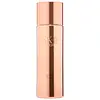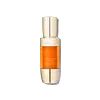What's inside
What's inside
 Key Ingredients
Key Ingredients

No key ingredients
 Benefits
Benefits

 Concerns
Concerns

 Ingredients Side-by-side
Ingredients Side-by-side

Water
Skin ConditioningButylene Glycol
HumectantGlycerin
HumectantCetyl Ethylhexanoate
EmollientMethyl Gluceth-20
HumectantBehenyl Alcohol
EmollientBetaine
Humectant1,2-Hexanediol
Skin ConditioningNiacinamide
SmoothingMethoxy PEG-114/Polyepsilon Caprolactone
BufferingCarbomer
Emulsion StabilisingTromethamine
BufferingPhenyl Trimethicone
Skin ConditioningCaprylyl Methicone
Skin ConditioningJojoba Esters
EmollientParfum
MaskingHydrolyzed Ginseng Saponins
Skin ConditioningGlyceryl Caprylate
EmollientPhenoxyethanol
PreservativeArachidyl Alcohol
EmollientEthylhexylglycerin
Skin ConditioningDisodium EDTA
Dextrin
AbsorbentTheobroma Cacao Extract
Skin ConditioningArachidyl Glucoside
EmulsifyingLinalool
PerfumingPanax Ginseng Seed Oil
EmollientGlycine Soja Oil
EmollientPanax Ginseng Root Extract
EmollientSodium Chloride
MaskingPanax Ginseng Leaf/Stem Extract
Skin ConditioningLimonene
PerfumingHoney
HumectantRehmannia Glutinosa Root Extract
Skin ConditioningPanax Ginseng Flower Extract
AntioxidantPaeonia Lactiflora Root Extract
Skin ConditioningLilium Candidum Bulb Extract
Skin ConditioningPolygonatum Odoratum Rhizome Extract
Skin ConditioningRetinol
Skin ConditioningNelumbo Nucifera Flower Extract
Skin ConditioningHydrogenated Lecithin
EmulsifyingAlcohol
AntimicrobialGlucose
HumectantTocopherol
AntioxidantCaprylyl Glycol
EmollientBHT
AntioxidantPentaerythrityl Tetra-Di-T-Butyl Hydroxyhydrocinnamate
AntioxidantPhytosphingosine
Skin ConditioningSodium Polyaspartate
HumectantSodium Hyaluronate
HumectantAcetyl Heptapeptide-4
HumectantSodium Methyl Stearoyl Taurate
CleansingAcetyl Hexapeptide-8
HumectantSodium Hydroxide
BufferingAcetyl Octapeptide-3
HumectantWater, Butylene Glycol, Glycerin, Cetyl Ethylhexanoate, Methyl Gluceth-20, Behenyl Alcohol, Betaine, 1,2-Hexanediol, Niacinamide, Methoxy PEG-114/Polyepsilon Caprolactone, Carbomer, Tromethamine, Phenyl Trimethicone, Caprylyl Methicone, Jojoba Esters, Parfum, Hydrolyzed Ginseng Saponins, Glyceryl Caprylate, Phenoxyethanol, Arachidyl Alcohol, Ethylhexylglycerin, Disodium EDTA, Dextrin, Theobroma Cacao Extract, Arachidyl Glucoside, Linalool, Panax Ginseng Seed Oil, Glycine Soja Oil, Panax Ginseng Root Extract, Sodium Chloride, Panax Ginseng Leaf/Stem Extract, Limonene, Honey, Rehmannia Glutinosa Root Extract, Panax Ginseng Flower Extract, Paeonia Lactiflora Root Extract, Lilium Candidum Bulb Extract, Polygonatum Odoratum Rhizome Extract, Retinol, Nelumbo Nucifera Flower Extract, Hydrogenated Lecithin, Alcohol, Glucose, Tocopherol, Caprylyl Glycol, BHT, Pentaerythrityl Tetra-Di-T-Butyl Hydroxyhydrocinnamate, Phytosphingosine, Sodium Polyaspartate, Sodium Hyaluronate, Acetyl Heptapeptide-4, Sodium Methyl Stearoyl Taurate, Acetyl Hexapeptide-8, Sodium Hydroxide, Acetyl Octapeptide-3
Ingredients Explained
These ingredients are found in both products.
Ingredients higher up in an ingredient list are typically present in a larger amount.
Betaine is a common humectant (a substance that promotes retention of moisture). It's known to be gentle on the skin and can help balance hydration.
This ingredient is best for improving hydration and soothing irritated skin. Studies also show it helps even out skin tone.
Fun fact: Betaine is naturally created in the skin and body. The kind found within cosmetic products can be either plant-derived or synthetic.
Another name for betaine is trimethylglycine.
Learn more about BetaineButylene Glycol (or BG) is used within cosmetic products for a few different reasons:
Overall, Butylene Glycol is a safe and well-rounded ingredient that works well with other ingredients.
Though this ingredient works well with most skin types, some people with sensitive skin may experience a reaction such as allergic rashes, closed comedones, or itchiness.
Learn more about Butylene GlycolGlycerin is already naturally found in your skin. It helps moisturize and protect your skin.
A study from 2016 found glycerin to be more effective as a humectant than AHAs and hyaluronic acid.
As a humectant, it helps the skin stay hydrated by pulling moisture to your skin. The low molecular weight of glycerin allows it to pull moisture into the deeper layers of your skin.
Hydrated skin improves your skin barrier; Your skin barrier helps protect against irritants and bacteria.
Glycerin has also been found to have antimicrobial and antiviral properties. Due to these properties, glycerin is often used in wound and burn treatments.
In cosmetics, glycerin is usually derived from plants such as soybean or palm. However, it can also be sourced from animals, such as tallow or animal fat.
This ingredient is organic, colorless, odorless, and non-toxic.
Glycerin is the name for this ingredient in American English. British English uses Glycerol/Glycerine.
Learn more about GlycerinWater. It's the most common cosmetic ingredient of all. You'll usually see it at the top of ingredient lists, meaning that it makes up the largest part of the product.
So why is it so popular? Water most often acts as a solvent - this means that it helps dissolve other ingredients into the formulation.
You'll also recognize water as that liquid we all need to stay alive. If you see this, drink a glass of water. Stay hydrated!
Learn more about Water